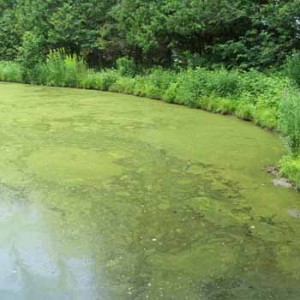How Do Changing Seasons Affect the Pond?
A pond without bottom aeration will go through predictable stages over the seasons. We will summarize here some of the processes that affect the pond over a year and you can judge the benefits of aeration.
Spring: Water Flow and Runoff
In the spring, after around May, the water in your pond is usually clear and beautiful. The snowmelt causes a phenomenon of water turnover, which renews the water over the entire column. There is usually enough oxygen to promote good degradation of organic sediments. Adding beneficial Bacterius® EQUINOX could speed up this process if you find yourself having an organic overload in your pond – which is very common with winter accumulations of dead leaves and other debris. Take advantage of this season! However, it is possible that your water become more turbid (brown, opaque) if a large amount of runoff brings in sediment, rich in nutrients. It may be a good idea to assess your pond’s watershed and make improvements if necessary.
 Summer: Hot Water + Nutrients = Algae Problems
Summer: Hot Water + Nutrients = Algae Problems
As summer approaches you are likely to witness an algal bloom encouraged by the increasing amount of nutrients. Without turnover of the water column, the sun’s rays will warm the upper layers of the pond over and over. This very warm water will sit over the deeper, cooler water . Now the unventilated pond is showing the first signs of surface algal bloom development. The water begins to lack oxygen and large amounts of algae die and sink to the bottom. An aeration system maintains a light circulation of water between the different layers, which prevents the formation of algae mats on the surface.
The destructive cycle begins with the long, hot days of late July, as the algae consume the last available nutrients in the pond and eventually die and sink to the bottom. Healthy green algae give way to blue-green algae that are harmful to the pond. These develop even without nitrogen and will quickly proliferate and affect the pond. Beneficial algae that have died and settled to the bottom of the pond begin to decompose, consuming oxygen which cannot be replaced due to lack of circulation. A diffuser station strategically placed at the bottom of the pond prevents this detrimental cascade.
The installation of an aeration system will maintain a constant circulation of oxygenated water between the different layers, which is the first defense against the growth of algae and phytoplankton. Adding an aquatic dye to the body of water also helps reduce light penetration, thereby reducing productivity and the plant biomass produced.
Fall: Input of Organic Matter in the Pond
Fall brings cooler temperatures and increased precipitation, which just like spring, tends to give your pond a youthful boost. It is a time when the water column is probably totally mixed, but also when large amounts of organic matter are brought into the water. The dead leaves fall from the trees and accumulate there, but the algae and aquatic plants in the pond also die and this biomass begins to degrade and in doing so consumes a lot of oxygen. If oxygen is lacking, decomposition cannot take place efficiently and sludge accumulates. Although it is possible to scrape the debris and remove it manually from your pond, using aeration as well as the application of Bacterius® EQUINOX can do the work for you to remove this organic matter, for a spring without muck, effortlessly!
Winter: Decomposition and Low Oxygen
From the first frosts of winter, ice forms on the surface and greatly reduces gas exchange (especially the diffusion of oxygen) with the sediments. As the constant decomposition of algae continues to deplete the oxygen available in the water, the nutrient-rich sediment layer thickens. With the depletion of oxygen, the first odors of hydrogen sulphide (rotten egg odor) will appear, problems with flavor and fish mortality, and an ever-increasing accumulation of mud at the bottom of the pond. An aeration system maintains a hole in the ice during the harsh winter and the continual oxygenation by the air bubbles promotes the natural breathing of the pond. The water remains clear and free of harmful compounds. The organisms necessary for the health of your pond – aquatic plants and other purifying algae – will participate in maintaining the quality of the water favorable for swimming, fishing, etc.
